
A Modern-day Agora
Notes after a visit to the SPARK Art Fair in Vienna
The previous weekend was marked by two major events in Vienna’s art scene: the Vienna Actionism Museum (WAM) opened its doors – a tribute to a significant artistic phenomenon of Viennese cultural life in the 1960s and 70s; and the third SPARK Art Fair took place at the Marx Halle from 15 to 17 March, this time under the motto ‘The City in Dialogue’. 90 galleries from all over the world took part in the fair, and in line with the fair’s concept, each gallery exhibited the work of just one artist at their stand. In total, more than 20 000 people attended the fair.
Both the title and the concept of the fair are, in a way, symbolic of spring – the time of year when nature awakens and bursts into life. At the same time, it is a time of cleansing, when all that is superfluous and dusty is swept away, making way for a new beginning. To paraphrase an ancient Buddhist quote, in order to pour something new into it, the vessel must first be emptied.
Photo: Arterritory.com
The fact that all the galleries within the fair have the same size booth and each gallery pays the same entry fee is also one of the features that distinguishes SPARK from its peers...including the ‘other’ Viennese art fair traditionally held in autumn – viennacontemporary.
With its undeniably bold approach, SPARK provisionally cleanses the classical art fair concept of all the superfluities that often make attending these events a rather exhausting experience – as well as one that paradoxically devalues the core values of art. Solo presentations or mini-exhibitions by a single artist are the antithesis of the established practice of the ‘supermarket fair’, where gallery booths display works by different artists side by side, often not even in dialogue with each other but rather in a competitive relationship. What’s more, often the same artists are represented by different galleries within the fair. This fragments the viewer’s attention, quickly leading to mental and physical fatigue. In turn, art itself often is reduced to the status of a blatant commodity that, whether it wants to or not, has to fight for the most prominent place on the ‘shelf’; otherwise it risks being overlooked altogether.
SPARK’s absolutely clear rules of the game are also a healthy dose of common sense in the current harsh geopolitical reality of uncertainty, insecurity and chaos, with the added accelerant of a media news stream that is constantly vying for public attention. Most of the time, they’re not even trying to contextualise or analyse what is happening anymore, but just throw it out as a topical contribution with which to manipulate people’s minds and emotions.
The effects of these processes are also being felt in the global art market, which is currently navigating an ‘uncertain economic and political future’, according to the Art Basel and UBS Global Art market Report 2024 released on 13 March. Total art market sales were down 4% in 2023, while public auction and dealer sales were down 7% and 3%, respectively, compared to 2022. The report cites the well-known factors of political and economic volatility as the most significant risks in 2024. Consequently, women artists have increased their position in both the primary and secondary art markets, although this is still considered to be too low. In 2023, they accounted for 40% of the market, an increase of 1% compared to 2022. Notably, women artists were at the forefront of sales at the SPARK art fair.
Billi Thanner. Pessimists Masquerading as Optimist, 2024. Galerie Artecont. Photo: Arterritory.com
In the context of art fairs, SPARK co-curator Marina Fokidis has repeatedly emphasised the importance of the legendary agora in the development of Greek culture and philosophy. In ancient Greece, the agora (meeting place/central square) was a place where all Greek citizens could assemble, from philosophers to simple craftsmen. The agora was a site for trading, negotiating and debating; it was where people discussed politics, the events of the day, art, religion and philosophy, and where they worshiped their gods. The ancient Agora of Athens is considered the cradle of democracy, and it was used as a place of assembly up until the 5th century.
Inserting this analogy into the context of SPARK, at the opening press conference Fokidis said that she is ‘happy to be surrounded by citizens from all over the world, each presenting their own subjective view.’
This is perhaps SPARK’s most important contribution – the fair’s scenography is very clear and understandable, and it allows the artworks, their viewers and potential buyers to ‘breathe’ (both mentally and physically). The artist and their story take priority, and in this format, that story can be recounted in its entirety. Consequently, the atmosphere at SPARK is surprisingly calm and relaxed; it’s a pleasant place to linger and engage in conversation, a characteristic that indirectly evokes the aforementioned agora.
Honza Zamojski. Christine Konig Galerie. Photo: Arterritory.com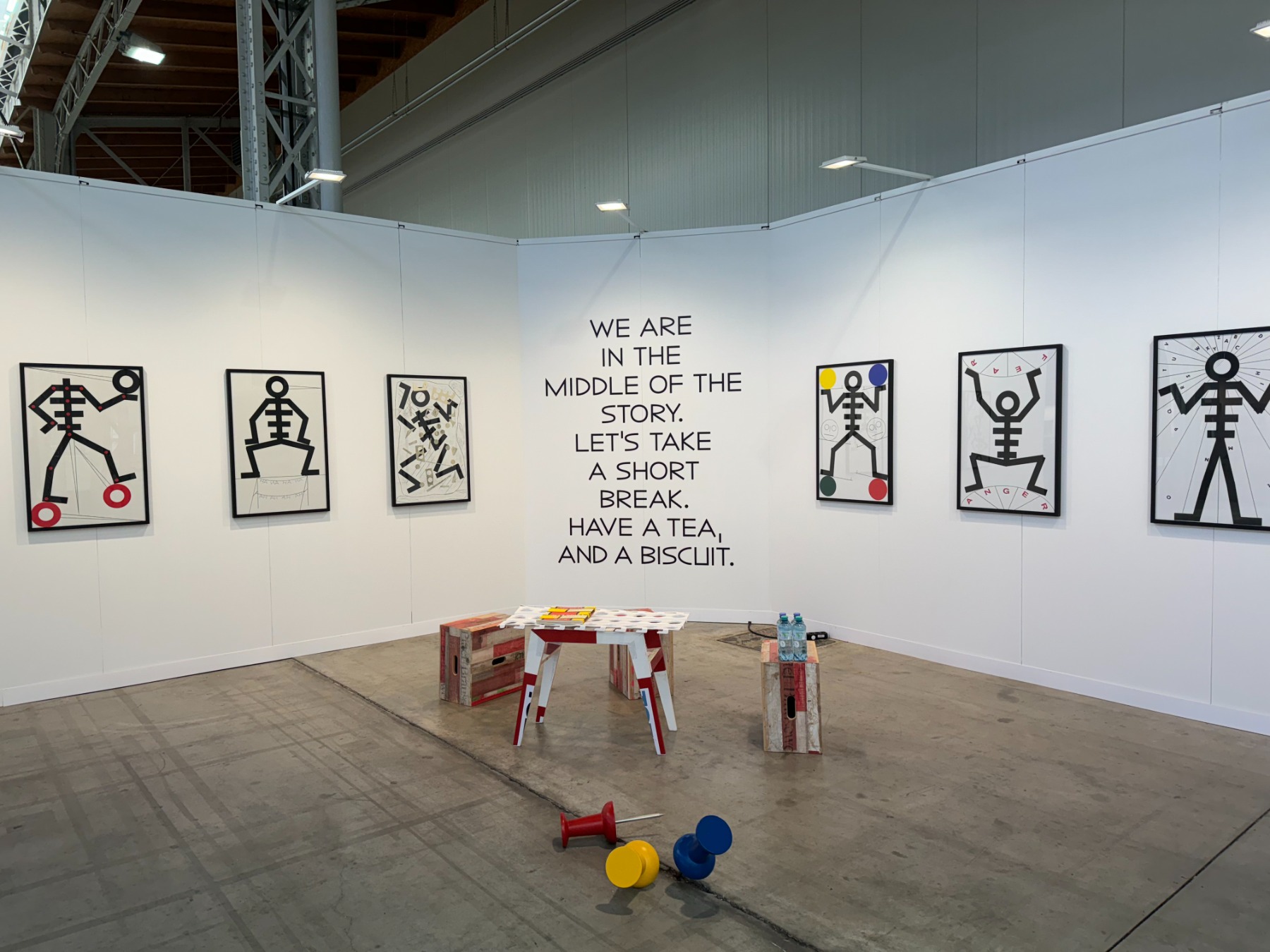
Another important feature of SPARK is that in addition to showing works by well-known artists, it also showcases works by artists who are very young, or, in some cases, perhaps not so young anymore but well-known locally if not internationally. In a way, SPARK is like a carefully curated group exhibition; in its essence, that is exactly what this fair is.
The fair’s team of curators and artistic advisors was as international as the gallery scene it represented. Marina Fokidis is from Greece, Walter Seidl lives in Vienna, Jan Gustav Fiedler has projects in Germany, Austria, Italy, Serbia and the USA, and Christoph Doswald is based in Zurich.
The geographic breadth of the galleries covered 20 countries and 4 continents – Europe, Africa, North America and South America. The themes that emerged in the artworks were universal and confirm that the problems that prevail in today’s world are the same as in the past. The only differences now are the ways in which they are expressed and the forms in which they are discussed. Obviously, art cannot solve the ills of a civilisation gone astray, but it can point them out in different ways while also offering various points of view.
Kevin Simon Mancera. Forget me not, 2023. Galerie Sturm&Schober. Photo: Arterritory.com

Vienna’s Galerie Sturm & Schober represented Colombian artist Kevin Simón Mancera, whose work Forget Me Not takes its title from the Myosotis plant species colloquially known as forget-me-nots, and symbolises a parting of ways, either temporary or final. The work was created during the pandemic and speaks about the fragility of life in a poetic and at the same time poignantly rational way. Mancera’s medium is drawing, and the work consists of a filigree series of drawings – similar to those in children’s educational encyclopedias – that are based on the IUCN Red List, i.e. animals, plants, birds and insects that are either threatened with extinction or are already extinct. At the same time, the work also highlights the same issue in terms of ourselves, human beings. If we do not take charge of our consumerism and power games, we too, in all our diversity, may one day become the subjects of such drawings – symbols of the shrinking biodiversity on planet Earth.
Panos Charalambous, Formation, 1998, Tobacco leaves, mixed mediaon canvas,180 x180 cm, Courtesy of CITRONNE Gallery
Ecology and the symbiotic relationship between nature and people is also the focus in the work of Greek artist Panos Charalambous, who was represented at SPARK by the Athens-based Citronne Gallery. Charalambous’ work is inspired by his home region of Xiromero, which is bordered by the Ionian Sea and the Achelous River, and he uses tobacco leaves as a metaphorical image in his pieces. They hold memories of the now vanished tobacco plantations and the once thriving farming community. Although the work was made in 1998, the tobacco leaves still retain their smell and texture, forming almost a sensory memory imprint. It is an aesthetically beautiful and somewhat sad reminder of the fragility of memories...as well as of the inner and outer harmony that we strive for, but at the same time, are continually destroying through our own actions, forgetting that our every action is governed by the law of causality, both on a daily and larger scale.
Panos Charalambous,Tobacco worker,1992,print of dibond,70x50 cm,ed.3+1 A.P, Courtesy of CITRONNE Gallery
‘Xiromero used to be a thriving agricultural and fishing community with very important local festivities. In the 1960s, there was huge interest coming from tobacco companies, which lead to a significant and violent strike. The artist was about 12 years old at that time, but he remembers it vividly. Nowadays, he reflects on this experience of being a farmer, a fisherman, and a member of the local community. This reflection is prompted by both his age, now in his 70s, and the new ecological challenges arising from drought in his area. Consequently, we believe his body of work is highly relevant as it addresses urgent ecological concerns today,’ explains Tatiana Spinari from Citronne Gallery.
When asked how she sees the concept of a solo presentation from the gallery’s point of view – especially considering that such a concept also entails the risk of not selling any of the works – Tatiana replies: ‘I think SPARK aligns with our spirit; it gives full power and autonomy to an artist. Because these kinds of works cannot be sold in parts, I think it is important to present them in their entirety. It’s a very holistic work, and SPARK provides this opportunity. As a creator in the gallery, I feel very excited to be working on a project like this because it enables me to promote a certain kind of thinking. I think it’s very relative to our times; we do care about selling, but we also care about the ideas we convey.’ Representatives from other galleries expressed a similar sentiment.
Anna Jermolaewa. Galerie Johann Widauer. Photo: Arterritory.com
Implicitly confirming the topical pulse of SPARK, the fair also featured works by Anna Jermolaewa. She will represent Austria at the 60th Venice Biennale this year. Born in Leningrad but based in Austria since 1989, her work at SPARK focused on an experiment carried out in the 1970s by Soviet psychologist Valeriya Mukhina, who (unsuccessfully) sought to prove that people who grow up under socialism are more resilient to conformism. Mukhina was inspired by a similar experiment carried out in the USA in the 1950s by American psychologist Solomon Asch. Mukhina showed two white pyramids to a kindergarten group, and when the children were asked what colour they were, they answered that they were both white. She then replaced one white pyramid with a black one and asked the children to continue saying that both pyramids were white. When a new child came into the group, hearing what the others were saying, he too confirmed that both pyramids were white. When the experiment was repeated with adults, there was a brief moment of confusion, but then they too announced that both pyramids were white. Jermolaewa was represented at SPARK by the Innsbruck-based Galerie Johann Widauer.
Almut Linde. Dirty Minimal. 33.3 - Bullet Action Painting Machine Cannon, 2006. PSM gallery. Photo: Arterritory.com
Then there was German artist Almut Linde (represented by the Berlin gallery PSM), who reflected on a world that exists but that we do not see in our everyday lives. Her material is reality, and she works with people who work or live in places where art is not usually present – soldiers in the military, war veterans, workers at slaughterhouses and nuclear power plants, etc. Linde’s exhibition at SPARK had two parts – one of which showed works made in collaboration with snipers in the German Bundeswehr. This artwork featured aluminium plates that the snipers use in their daily target practice, as well as glass plates, which Linde specially asked the soldiers to shoot through. Given that a sniper’s main task is to just hit the target, needless to say, the aestheticisation of the objects that they use for shooting practice came as a surprise to them. In the second part, Linde, together with war veterans suffering from post-traumatic stress disorder, had created a series of clay objects that visually express the veterans’ emotional world and traumatised psyche.
War encompasses many aspects, including a massive for-profit industry; the aluminium plates that snipers shoot through are produced by someone for this very purpose. Admittedly, once they’re shot-up, the plates look extremely good from an aesthetic perspective – they could easily serve as beautiful design-objects executed in a ‘robust minimalist aesthetic’. The artist herself calls it ‘radical beauty’, a phrase that also embodies the utter absurdity of the world.
Work by Esther Ferrer. Gandy gallery. Photo: Arterritory.com
Bratislava’s Gandy Gallery showed works by 86-year-old Spanish performance artist Esther Ferrer – witty objects made from obsolete things and materials that could arguably be called trash, seemingly insignificant items. Ferrer has given them a whole new life (one that is open to interpretation), and it is impossible to look at these objects without smiling. Ferrer is interested in the unexpected, transformation, humour, chance and continuity.
Pierre Vermeulen. Die rooi skadu swart, 2023. Reservoir gallery. Photo: Arterritory.com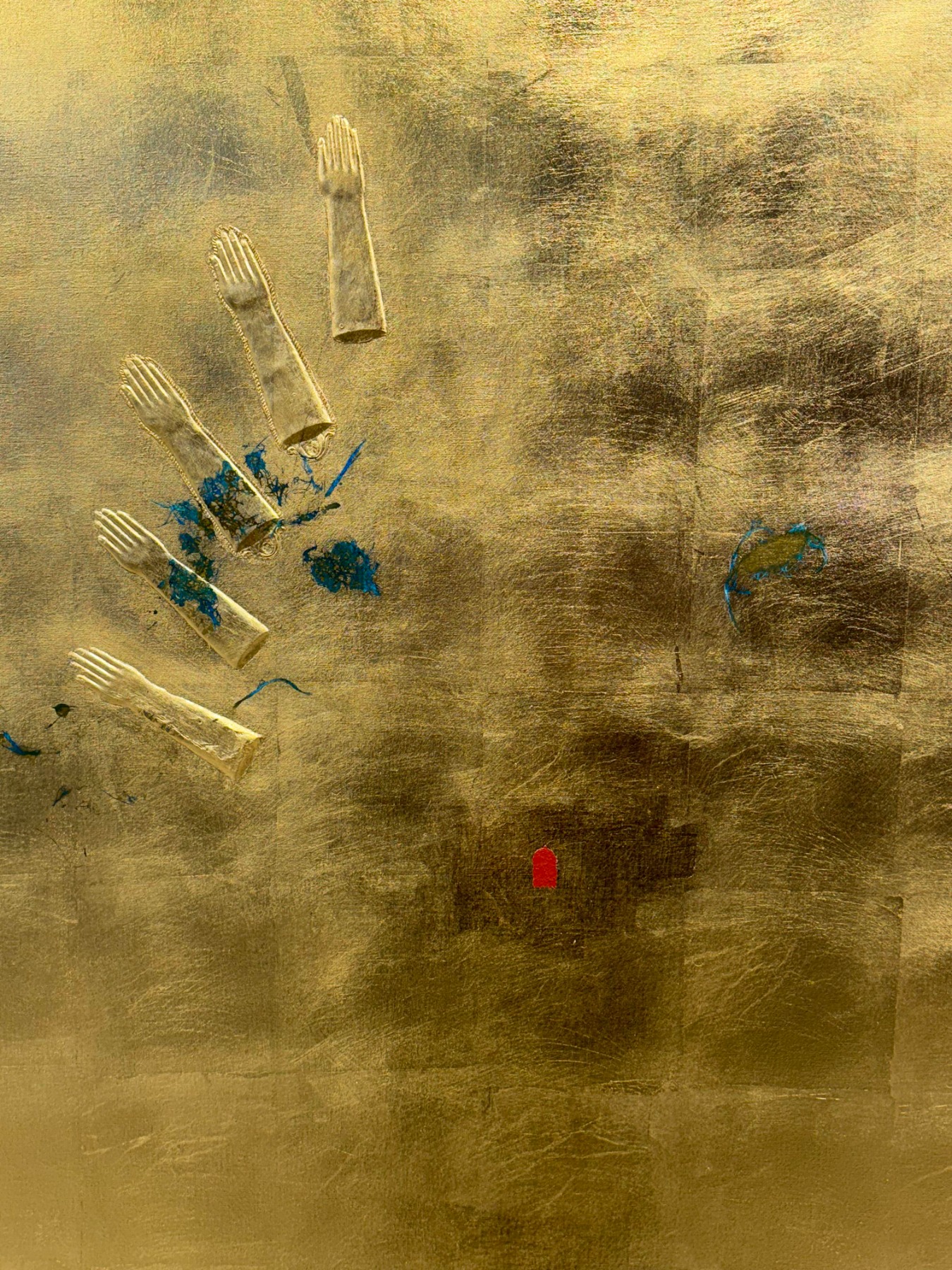
A tendency evident in many of the works on show at the fair was nuanced experimentation with materiality, seeking to push the boundaries of painting. The South African-based gallery RESERVOIR Projects showed works by Cape Town-based artist Pierre Vermeulen. His work is rooted in meditation, which he also practises. But they are also exercises in alchemy – Vermeulen affixes imitation gold leaf to Belgian linen, on which he then places orchids woven from human hair which have been soaked in his own sweat. This causes corrosive oxidation, and when Vermeulen deems the process complete, he removes the flowers. The process results in mystical imprints with a reflective texture. In places, a stray hair can still be seen on the surface of the work.
‘There’s a moment during meditation when you face yourself and become aware of it. So, standing in front of this reflective surface, the viewer catches a glimpse of their own shadow. This concept can be likened to various philosophical points of view, and it’s reminiscent of Plato’s allegory of the cave. Initially, you only perceive the shadows, but upon emerging from the cave, you behold the genuine archetypes for the first time,’ says Shona van der Merwe, co-founder of RESERVOIR Projects.
Carl Andre. 8x8 Cedar Solid, 2011. Konrad Fischer galerie. Photo: Arterritory.com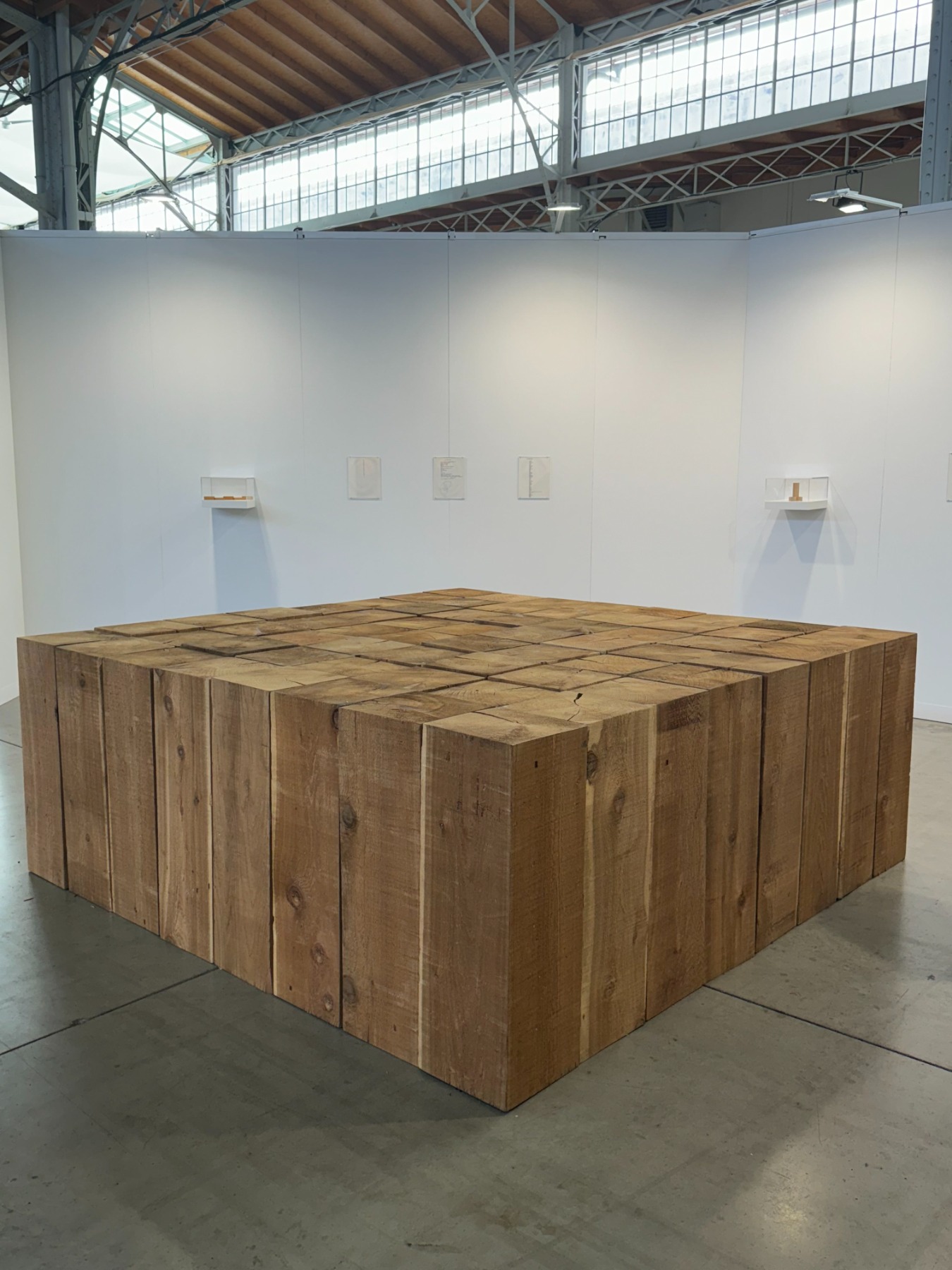
In an undoubted effort to attract attention, the fair had also strategically placed on view works by some of the classics: Hermann Nitsch, Franz West, Arnulf Rainer, Gottfried Helnwein, Robert Zeppel-Sperl, and Carl Andre. Given that American minimalist classic Carl Andre passed away in January of this year, his work 8x8 Cedar Solid, consisting of 64 cedar blocks and on display at the Konrad Fischer Galerie stand, was a beautiful and very poetic tribute to the artist.
Large-scale work by Refik Anadol. Photo: Arterritory.com
Artificial intelligence and digital artworks were also represented at SPARK, the most notable being the large-scale work by Refik Anadol located right next to the fair’s café. It duly entertained the event’s youngest visitors, as well as restfully hypnotised fairgoers who needed a short break between wandering among gallery stands, taking them into a slightly different world for a moment.
Hanakam&Schuller. PAN AU, 2023. Galerie Krinzinger. Photo: Arterritory.com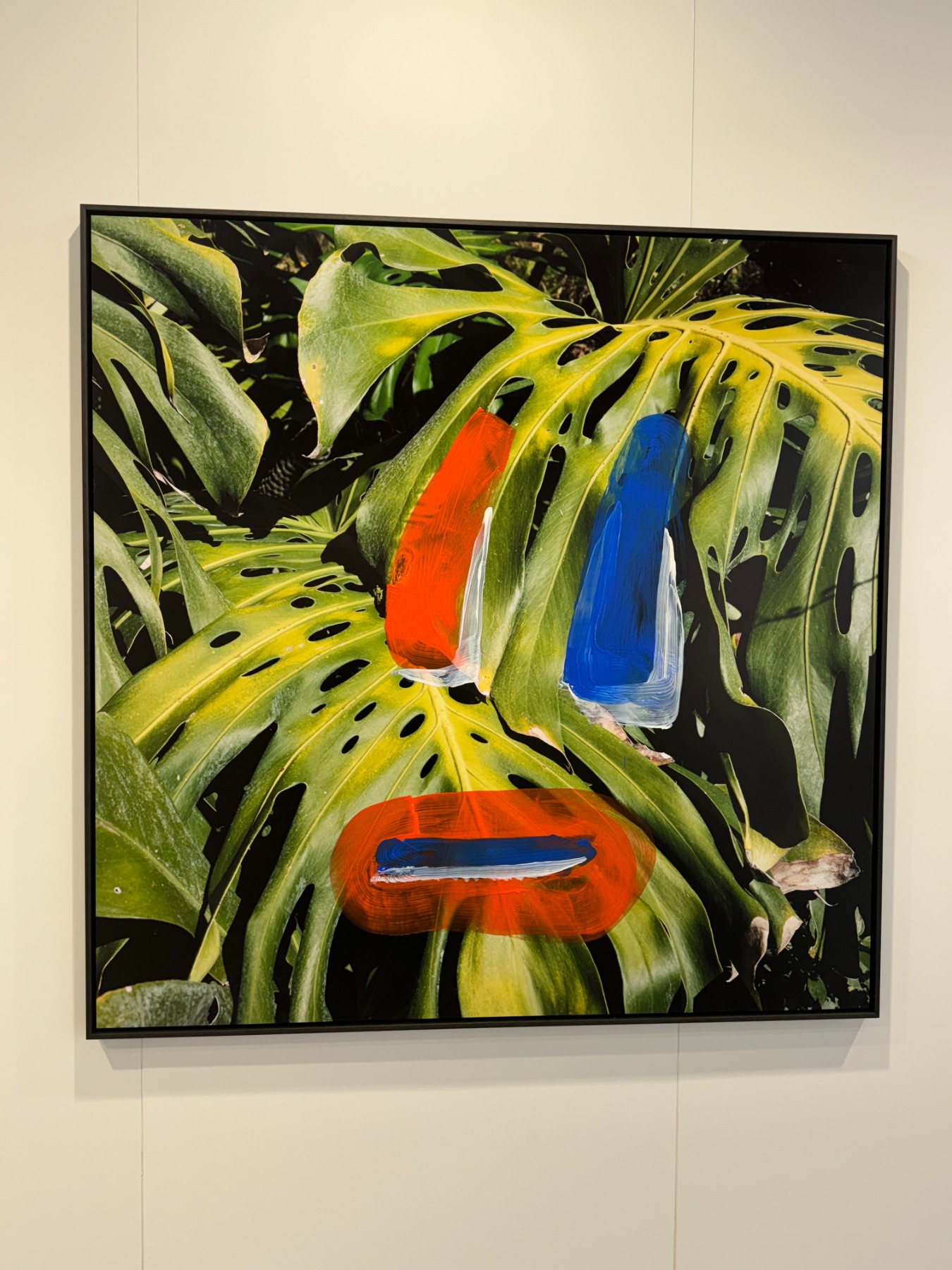
Digital animation techniques were on display in the work PAN AU by the artist duo Hanakam & Schuller, represented by Galerie Krinzinger. Their three-medium photographs are based on close-ups of plants in a botanical garden to which the artists have applied artificial intelligence software that reads out motion track vectors for facial recognition. The duo then paints on mask-like brightly coloured fields with an acrylic medium. According to Hanakam & Shuller, the works ‘pose topical questions about our dealings with the nomenclature of “more-than-human”.’
Marko Marković. Iron Waterfall, installation, 2022. Galerie Michaela Stock. Photo: Arterritory.com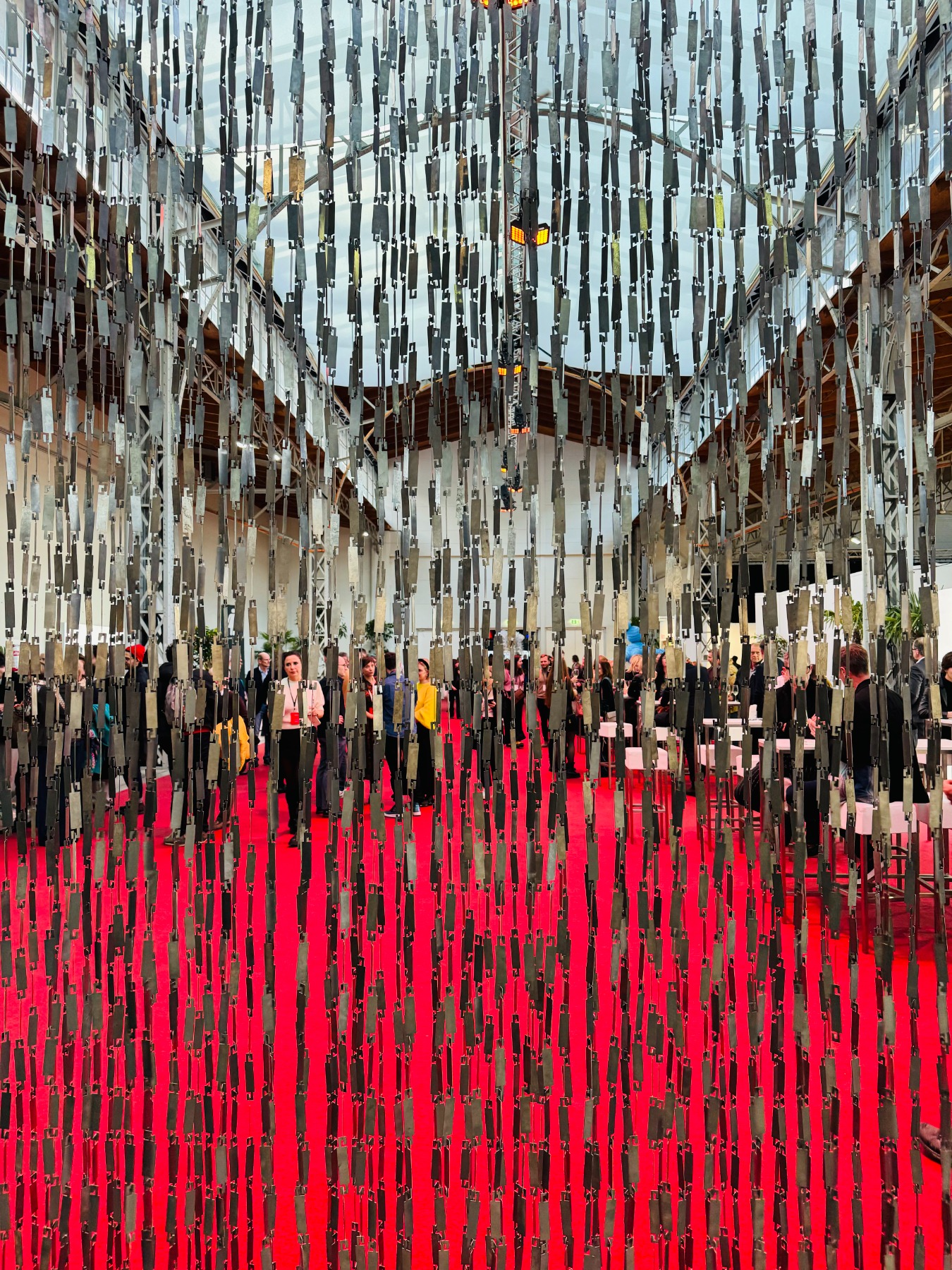
One of the first works a visitor to SPARK encountered upon entering (and which was the last one seen as they left) was Marko Marković’s installation Iron Waterfall, which consists of thousands of small iron plates chained together. Hanging in the shape of a gigantic drapery, it is basically what one would imagine the intimidating maxim of an ‘iron curtain’ to literally look like. Yet it’s ‘weave’ is also loose and airy enough to ward off any foreboding connotations as fiction. It is a poignant reminder of the times we live in and an invitation to enjoy the moment. Joy breeds joy, creativity breeds creativity, fear breeds fear, and negativity breeds negativity. Undeniably, the SPARK art fair increases joy and the desire to talk with others, a true accomplishment in today’s complex reality.
*Material produced with the support of Wien Tourismus.
